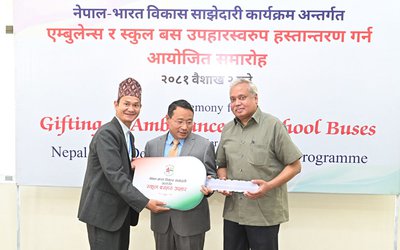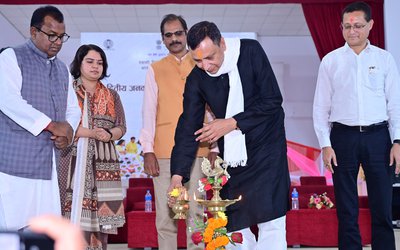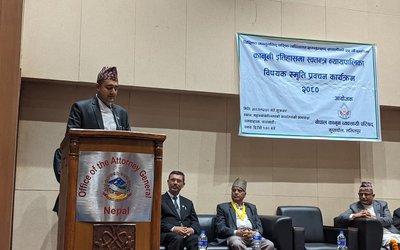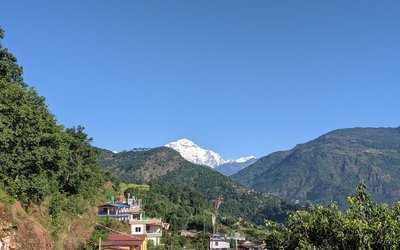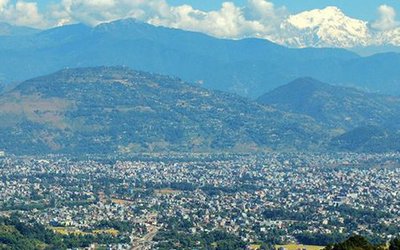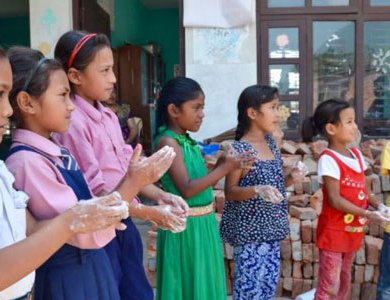
Although there are various programs and projects fir children, they have yet to address their tender concerns. The recently released Nepal Children’s Earthquake Recovery Consultation Report shows what the children point out as their areas of priority
Shanti Tamang, 13, is a student of Nandi Ratri Higher Secondary School. Although the school is situated at the heart of the capital, students like Tamang are in temporary bamboo structures waiting for peace and relief.
“Surrounded by piles of debris nearby, we cannot forget the quake. With regular experiences of small aftershocks, we are scared,” said Tamang.
The state of children of Sankhu,12 kilometers northeast of the capital, is worse as they have to live in a city with damaged houses and buildings.
Although more than three months have already passed since the devastating earthquake hit Nepal, destroying homes and buildings, life is yet to improve at a desired pace. Debris of damaged school buildings, residential houses, health pots and buildings of VDCs are lying here and there as the earthquake reminiscence.
At a time when many old people are in the process of recovering, the existing state of earthquake devastated region has left long-lasting negative impacts on the minds of children and many continue to live in fear.
Prepared by Plan International, Save the Children, UNICEF and World Vision, in collaboration with the Ministry of Federal Affairs and Local Development and Central Child Welfare Board, Nepal Children’s Earthquake Recovery Consultation report, After the Earthquake, Nepal’s Children Speak Out, narrates the voices of children living in 14 most-affected districts.
The report shows how fearful children are in the present circumstances. “Our houses have been destroyed. We are living in tents and cannot sleep at night.”
“The entire family is sleeping together under the same tarpaulin. Being a girl, it becomes really uncomfortable for us while changing clothes. Particularly during the menstrual cycle, changing pads inside the tarps and washing it openly is really embarrassing. We don’t know when we will have a new house,” the report notes a typical voice of a girl child.
“I don’t feel like going to school because the buildings are completely damaged and it look scary. The water source is contaminated with a mixture of mud and stone. We are afraid of getting diarrhea as we are compelled to drink that water," another alarming note is there.
“Death of people and damage to the village, along with rumors of the end of world, have given birth to a sense of hopelessness in our hearts.
“After a year, I want to see my village develop. There will be the market. There will be earthquake-resistant houses. I wish to see greenery and peace.”
“I still have hope. For now, we can study under tarps and I believe that after a year the school building will be reconstructed, so I want stop chasing my dreams.”
Children identified three priority areas. They include adequate temporary secure shelters, reopening of schools, and improved access to safe water supplies, sanitation and medical care.
Launched by a group of Nepalese children, After the Earthquake Nepal’s Children Speak Out, Nepal Children’s Earthquake Recovery Consultation Report, is the first of its kind to highlight the situation of children in the earthquake devastated areas.
The impacts expressed by children include profound feeling of sadness and grief, fear of another earthquake and other potential threats, an increased burden of domestic chores and other tasks and increased feelings of vulnerability, particularly among girls, to exploitation and abuse.
The report also highlights the importance of involving children in disaster preparedness planning to make sure they are at less risk when future disasters occur.
This report is based on one of the largest ever child consultations undertaken following a disaster, nearly 2,000 children who survived the earthquakes in Nepal have expressed fear and insecurity at having to live in tents and overcrowded shelters, with anxiety about the risks to their health from unsanitary conditions, and worries about their future if they cannot return to school.
“Ministry of Federal Affairs and Local Development is happy to be a part of the report. This report helps our ministry to prepare future plan in the process of reconstruction,” said Reshmi Raj Pandey, joint secretary at Ministry of Federal Affairs and Local Development. “Our experience is that the voices of the grass-root people is important to make successful plans. Based on the consultations at the grass root level, the report prepared by renowned international organizations specializing on children will benefit all of us.”
The aid organizations that carried out the consultations– Plan International, Save the Children, UNICEF and World Vision – highlight the need to strengthen the resilience of communities against major disasters. The report warns of severe risks to children’s health, well-being and protection during the monsoon season unless urgent humanitarian needs are met.
“There is the need of intense consultations with different stakeholders, including Ministry of Education, before publishing the report. As the earthquake badly damaged the school buildings, there is the need to construct 30,000 new classrooms and 10,000 schools in the coming three years. The report presented the challenges but it failed to identify the capability,” said Dr. Hari Lamsal, joint secretary and spokesperson of Ministry of Education. Despite certain lapses, the positive side of the report is that it reveals where the lapses are and what children want in future.”
The report is full of frustration and hope of children. Girls and boys described the difficulties of living in temporary shelters that were neither water or wind-proof in the aftermath of the earthquakes.
“As the government is preparing the settlement plan for the earthquake affected areas, the new school buildings and houses will be more children friendly,” said the representative of Ministry of Urban Development. “This report gives us to a chance to understand the opinion of children from the grass root level.”
“Our shelter is at high risk of heavy storms. We were forced to stay awake for a whole night to hold on to the tarpaulins to save them from blowing away,” said a young boy in Nuwakot, one of the 14 most affected districts, where children were consulted.
“Tens of thousands of children are living in inadequate shelters. Despite efforts to help earthquake-affected communities, it is still a race against time to provide basic needs of shelter, sanitation and protection," said Lucia Withers, Save the Children’s Humanitarian Advisor and author of the report.
Children expressed concern about the lack of privacy and space, with some younger children fearing attacks by wild animals. Girls in particular reported feeling vulnerable in shelters shared with extended families and neighbors while others felt subjected to sexual harassment and feared an increase in trafficking.
At the function organized jointly by Plan International, Safe the Children, Unicef and World Vision in collaboration with Ministry of Federal Affairs and Local Development and Central Child Welfare Board, speakers stressed the need to listen to the voices of the children.
The aid organizations that carried out the consultationsalso warned of severe risks to children’s health, well-being and protection during the monsoon season unless urgent humanitarian needs are met.
Girls and boys described the difficulties of living in temporary shelters and lack of health facilities around the village, particularly lack of medical practitioners in the health post.
“As pointed out in the report, Ministry of Population and Health is seriously considering to send at least a senior health assistant to the health posts of 14 most affected districts,” said a representative from the Ministry of Population and Health.
“With the monsoon season intensifying, we must act quickly and effectively to ensure the welfare of earthquake-affected children and their families is addressed. Children have lived through a hugely distressing experience which has also disrupted their education and they urgently need psychosocial support to recover,” said Admir Bajrami, World Vision’s Nepal Earthquake Response Operations.
Children who took part in the consultation provided detailed and practical recommendations on how to rebuild their lives and communities, including the need for earthquake-resistant homes, schools and other buildings. Children also want to be better prepared for future earthquakes.
Children suggested that schools be run in tents or other temporary shelters until new schools have been built and called upon the government to replace the books, stationery and other school materials that were buried under the rubble of their homes. Furthermore, they called for stronger protection for themselves and other children in their communities.
“Children’s lives in earthquake-affected areas have been turned upside down. The world must wake up to the fact that it is absolutely critical that children are factored in for any disaster preparedness and response efforts to be successful,” Dr. Unni Krishnan, Plan International’s Head of Disaster Preparedness and Response, said.
Despite the huge challenges faced by the earthquake survivors, children also talked of communities rallying to help each other. In the consultation, children showed remarkable levels of resilience and optimism highlighting that their lives would be normal and even improve through the support of their communities.
“These children have provided us with valuable insights that could have been missed by adult eyes. These suggestions now need to guide our programs in the rest of the country, to better prepare all communities in Nepal for impending disasters,” said Dr. Rownak Khan, UNICEF Deputy Representative.
Based on the consultations report, its sponsors urged that the ongoing support for assistance priority is accorded to shelter, education, health and sanitation, child protection and psychosocial support, disaster risk reduction and children’s participation.
- TANAHU HYDROPOWER PROEJCT: A Significant Achievement
- Apr 15, 2024
- AMBASSADOR HANAN GODAR: Sharing Pain With A Nepali Family
- Mar 30, 2024
- VISIT OF KfW AND EIB TO NEPAL : Mission Matters
- Mar 25, 2024
- NEPAL BRITAIN SOCIETY: Pratima Pande's Leadership
- Mar 24, 2024
- NEPAL ARMY DAY: Time To Recall Glory
- Mar 15, 2024



